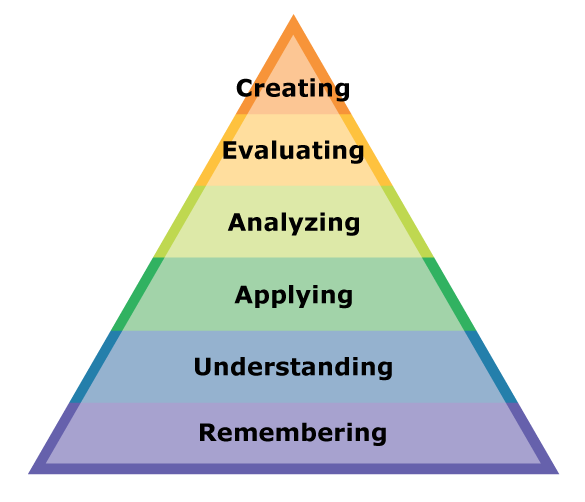Bloom’s taxonomy is a classification system used to define and determine different levels of human cognition—such as thinking, learning, and understanding.
Educators have typically utilized Bloom’s taxonomy to inform or guide the development of assessments, curriculum, and instructional methods such as questioning strategies.
History
- Original Taxonomy
Bloom’s taxonomy was originally published in 1956 by a team of cognitive psychologists at the University of Chicago. It is named after the committee’s chairman, Benjamin Bloom (1913–1999). The original taxonomy was organized into three domains: Cognitive, Affective, and Psychomotor.
Educators have primarily focused on the Cognitive model, which includes six different classification levels: Knowledge, Comprehension, Application, Analysis, Synthesis, and Evaluation. The group sought to design a logical structure for teaching and learning goals that would help researchers and educators understand the basic ways in which people acquire and develop new knowledge, skills, and understandings. Their initial intention was to help academics avoid duplicative or redundant efforts in developing different tests to measure the same educational objectives. The system was originally published under the title Taxonomy of Educational Objectives: The Classification of Educational Goals, Handbook 1: Cognitive Domain.
Some users of the taxonomy place more emphasis on the hierarchical nature of the framework, asserting that the first three elements—Knowledge, Comprehension, andApplication—represent lower levels of cognition and learning, while Analysis, Synthesis, and Evaluation are considered higher-order skills. For this reason, the taxonomy is often graphically represented as a pyramid with higher-order cognition at the top.
While Bloom’s taxonomy initially received little fanfare, it gradually grew in popularity and attracted further study. The system remains widely taught in undergraduate and graduate education programs throughout the United States, and it has also been translated into multiple languages and used around the world.
- Revised Taxonomy
In 2001, another team of scholars—led by Lorin Anderson, a former student of Bloom’s, and David Krathwohl, a Bloom colleague who served on the academic team that developed the original taxonomy—released a revised version of Bloom’s taxonomy called A Taxonomy for Learning, Teaching, and Assessing: A Revision of Bloom’s Taxonomy of Educational Objectives. The “Revised Bloom’s Taxonomy,” as it is commonly called, was intentionally designed to be more useful to educators and to reflect the common ways in which it had come to be used in schools.
In the revised version, three categories were renamed and all the categories were expressed as verbs rather than nouns. Knowledge was changed to Remembering, Comprehension became Understanding, and Synthesis was renamed Creating. In addition, Creating became the highest level in the classification system, switching places with Evaluating. The revised version is now Remembering, Understanding, Applying, Analyzing, Evaluating, and Creating, in that order.
Issues
- Whether human cognition can be divided into distinct categories, particularly sequential or hierarchical categories. Others embrace the utility of the classification system, while still recognizing that it does not—and cannot—represent human thought or learning in all their complexity and sophistication.
- Most criticism is focused less on the system itself and more on the ways in which educators interpret and use the taxonomy. For example, teachers may view the system as linear prescription, believing that students must first begin with remembering, move on to understanding, and proceed through the levels to creating.
- Other educators may place too much emphasis on the significance of higher-order thinking—at the expense of lower-order skills—despite the fact that acquiring a strong foundation of knowledge, information, and facts is essential in the application of higher-level thinking skills.
- Some educators have even suggested an alternative formulation, suggesting that the taxonomy should be reversed because higher-level thinking skills require that students both remember and understand underlying concepts first.
- Others suggest that the taxonomy should be interpreted as a non-hierarchical continuum in which no one form of cognition is more or less important.
While still widely used, Bloom’s taxonomy is gradually being supplemented—and may perhaps even supplanted one day—by new insights into the workings of human thought and learning made possible by advances in brain imaging and cognitive science. Still, it is likely, given its logical simplicity and utility, that Bloom’s taxonomy will continue to be widely used by educators.
